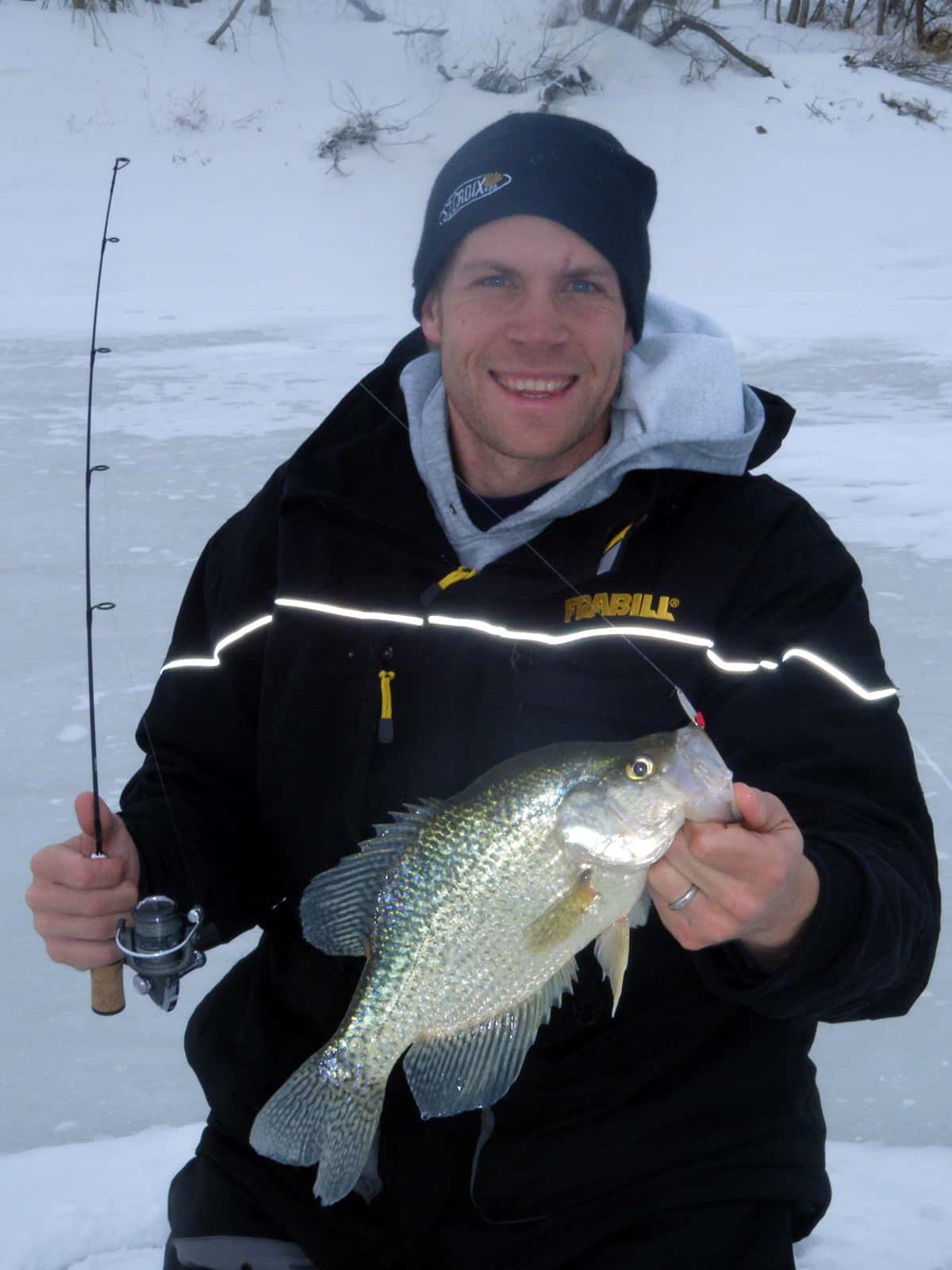
The author with a 13-inch crappie caught by presenting a small spoon slightly above the school, triggering a rise and a take. Simonson Photo.
By Nick Simonson
Of note on crappies of both stripes, or specks as it were, are their large eyes. Both white and black crappies have enormous peepers mounted at the front of their heads, and they use them to target their prey in both summer and winter.
Capitalizing on this dominant sense is an important tactic for ice anglers in the early goings as both aggressive methods and some subtle presentations along with fine tuning can pay off in triggering a bite. What follows is some key insight into crappie visual acuity, related behavior and how to connect with them as a result of their powerful sense of sight.
The Eyes Have It
Those big eyes and the way they are mounted – on the upper portion of their head – should be the first clue that crappies tend to look up in the world around them. Crappies will often rise to an offering under the ice, but seldomly drop down to investigate a lure or bait and this is a function of their anatomy. As a result, when a crappie – or a whole school of them – shows up on a sonar display, it is important to present a lure or a bait above the mark. Crappies will rise up to investigate a jiggled spoon tipped with a minnow head, or a jig with a pair of maggots or a waxworm kicking off of its back end.
Rising fish typically equal interested fish, so keep an eye on the sonar and wait for the strike or a subtle inhale telegraphed on a spring bobber before setting the hook.
Bring ‘Em In
As their eyes are bigger than many of their panfish contemporaries, crappies have a strong sense of vision and can pick out prey at a distance and identify smaller food items as well. Additionally, many crappie bites manifest at dawn and dusk, and sometimes even run the whole night on lakes where these panfish are present. Utilize flashy baits such as small spoons and tiny swimming lures like the Rapala Jigging Rap, to draw fish in for a look. Tip the treble with a minnow head or replace it with a dropper hook baited with maggots. Crappies will see the action from a distance away and move in for a better look. As the preferred depth of fish becomes apparent, remember to keep the lure up a little bit from where fish seem to be cruising in, in order to maintain that visibility and identify active fish which will rise to the offering.
Small Can Be Big
Crappies have been known to feed on tiny insect larvae and small aquatic life forms such as daphnia which are little crustaceans that can be less than five millimeters in length. Their powerful eyes can track the motion and the rise of these tiny morsels during low light hours and help fill the void when it comes to food. As such, don’t be afraid to target crappies by offering something smaller, like a 1/64-ounce jig tipped with a maggot or two, especially when a school has been found but the bite isn’t fast and furious and specks spurn spoons for something more natural.
In addition to live maggots, a selection of artificial baits such as Berkley Gulp! maggots and waxworms will work as well. Just make sure the bait presents naturally on the chosen jig and produces a little kicking motion when jiggled in the water column. Natural presentation is key to converting approaching fish into takers of these smaller snack-sized offerings.
Discerning View
Keeping those presentations natural is an acquired skill, a function of heightened attention to detail and it all starts with the line on the reel. Especially in clear waters, try to get away with the lightest line possible.
Two- or three-pound-test is not out of the question, and at no time should the line be any thicker than four-pound-test for crappie related applications. Make sure that knots ride at the 12 o’clock position on any jig, such as a Lindy Fat Boy or Northland Bro Bug, where a horizontal presentation is required to make the lure sit right and present any attached bait properly. Crappies are quick to turn up their pointy noses at offerings that look unnatural and lure spin is a huge catalyst for repelling otherwise aggressive fish.
It’s wise from time-to-time to cut and retie the jig on the line, especially after a few fish have stretched and torqued the monofilament which in turn causes lure spin. Check lures in the hole just below the water’s surface to make sure they aren’t rotating unnaturally before dropping them down to the fish waiting in the column.
Focus on the crappie’s sense of sight this ice season to get a better understanding of how they react to offerings large and small, and take a second look at how baits move in the water to catch more fish all winter long.

